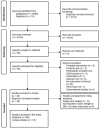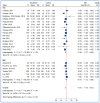Lifestyle Interventions to Prevent Type 2 Diabetes in Women with a History of Gestational Diabetes: A Systematic Review and Meta-Analysis through the Lens of Health Equity
- PMID: 37960319
- PMCID: PMC10649749
- DOI: 10.3390/nu15214666
Lifestyle Interventions to Prevent Type 2 Diabetes in Women with a History of Gestational Diabetes: A Systematic Review and Meta-Analysis through the Lens of Health Equity
Abstract
Background: Type 2 diabetes mellites is one of the health problems disproportionally affecting people with low socioeconomic statuses. Gestational diabetes mellites increases the risk of type 2 diabetes by up to ten-fold for women. Lifestyle interventions prevent type 2 diabetes in women with prior gestational diabetes. However, it is unknown if similar effectiveness can be expected for all population subgroups.
Objective: This study aims to assess the prevention of type 2 diabetes in women with prior gestational diabetes using population characteristics according to the PROGRESS (place of residence, race/ethnicity/culture/language, occupation, gender/sex, religion, education, socioeconomic status, and social capital) criteria.
Methods: MEDLINE, CINAHL, EMBASE, PubMed, PsycINFO, Web of Science, and EBM Reviews databases were searched for interventional studies of diet, physical activity, or behavioural interventions published up to 21 February 2023. Random effects subgroup meta-analysis was conducted to evaluate the association of population characteristics and intervention effects.
Results: All studies were conducted in high-income countries or middle-income countries. Two-thirds of the studies reported on race/ethnicity and education level. Less than one-third reported on place (urban/rural), occupation, and socioeconomic status. None reported on religion or social capital. Studies from high-income countries (MD = -1.46; 95% CI: -2.27, -0.66, I2 = 70.46, p < 0.001) showed a greater reduction in bodyweight compared with the studies conducted in middle-income countries (MD = -0.11; 95% CI: -1.12, 0.89, I2 = 69.31, p < 0.001) (p for subgroup difference = 0.04).
Conclusion: There are significant equity gaps in the evidence for the prevention of type 2 diabetes in women with prior gestational diabetes due to reports on population characteristics being poor. Interventions may be less effective in reducing bodyweight in women from middle-income countries compared to high-income countries. Collecting and analysing data related to equity is needed to understand the effect of lifestyle interventions on type 2 diabetes for different population subgroups.
Keywords: diabetes gestational; diabetes mellites type 2; equity; lifestyle intervention; meta-analysis; progress.
Conflict of interest statement
The authors declare no conflict of interest. The funders had no role in the design of this study; in the collection, analysis, or interpretation of the data; in the writing of the manuscript; or in the decision to publish the results.
Figures
Similar articles
-
Lifestyle interventions for the treatment of women with gestational diabetes.Cochrane Database Syst Rev. 2017 May 4;5(5):CD011970. doi: 10.1002/14651858.CD011970.pub2. Cochrane Database Syst Rev. 2017. PMID: 28472859 Free PMC article.
-
Interventions to increase attendance for diabetic retinopathy screening.Cochrane Database Syst Rev. 2018 Jan 15;1(1):CD012054. doi: 10.1002/14651858.CD012054.pub2. Cochrane Database Syst Rev. 2018. PMID: 29333660 Free PMC article.
-
Combined diet and exercise interventions for preventing gestational diabetes mellitus.Cochrane Database Syst Rev. 2017 Nov 13;11(11):CD010443. doi: 10.1002/14651858.CD010443.pub3. Cochrane Database Syst Rev. 2017. PMID: 29129039 Free PMC article.
-
Dietary advice interventions in pregnancy for preventing gestational diabetes mellitus.Cochrane Database Syst Rev. 2017 Jan 3;1(1):CD006674. doi: 10.1002/14651858.CD006674.pub3. Cochrane Database Syst Rev. 2017. PMID: 28046205 Free PMC article.
-
Interventions to improve access to cataract surgical services and their impact on equity in low- and middle-income countries.Cochrane Database Syst Rev. 2017 Nov 9;11(11):CD011307. doi: 10.1002/14651858.CD011307.pub2. Cochrane Database Syst Rev. 2017. PMID: 29119547 Free PMC article.
Cited by
-
A Systematic Review and Meta-Analysis of Type 2 Diabetes Prevention Through Lifestyle Interventions in Women with a History of Gestational Diabetes-A Summary of Participant and Intervention Characteristics.Nutrients. 2024 Dec 23;16(24):4413. doi: 10.3390/nu16244413. Nutrients. 2024. PMID: 39771034 Free PMC article.
-
Global, regional, and national burden of diabetes in women of childbearing age, 1990-2021: a systematic analysis from the global burden of disease study 2021.Front Glob Womens Health. 2025 Jul 15;6:1528661. doi: 10.3389/fgwh.2025.1528661. eCollection 2025. Front Glob Womens Health. 2025. PMID: 40735640 Free PMC article.
-
Preventing Type 2 Diabetes in Women With Gestational Diabetes: Three Theoretical Perspectives on Behavior Change.J Midwifery Womens Health. 2025 Jul-Aug;70(4):545-548. doi: 10.1111/jmwh.13747. Epub 2025 Mar 20. J Midwifery Womens Health. 2025. PMID: 40109026 Free PMC article. No abstract available.
-
The long-term general practice healthcare of women with a history of gestational diabetes: A Scoping Review Protocol.HRB Open Res. 2025 Apr 10;8:31. doi: 10.12688/hrbopenres.14022.2. eCollection 2025. HRB Open Res. 2025. PMID: 40225808 Free PMC article.
-
Effectiveness of a Family-based Health Promotion Intervention for Women With Prior GDM: The Face-It RCT.J Clin Endocrinol Metab. 2025 Jul 15;110(8):e2456-e2470. doi: 10.1210/clinem/dgae856. J Clin Endocrinol Metab. 2025. PMID: 39657967 Free PMC article. Clinical Trial.
References
-
- IDF . Diabetes Atlas. 10th ed. IDF; Springfield, MO, USA: 2021.
Publication types
MeSH terms
Grants and funding
LinkOut - more resources
Full Text Sources
Medical



